Heading out the door? Read this article on the new Outside+ app available now on iOS devices for members! Download the app.
If we reserved hikes, backpacking trips, and other outings for T-shirt weather, we’d rarely leave the house. The best rain jackets enable us to explore despite the elements—which is exactly what our team of testers did all year long. Below, you’ll find our favorite men’s shells of 2025, from featherweight rain jackets to heavy-duty hardshells ready to weather any storm. Read up, layer up, and head out.
Best Men’s Rain Jackets at a Glance
- Best Quiver-Killer: Helly Hansen Verglas Infinity Shell Jacket 2.0 ($350)
- Best All-Arounder: Rab Namche Paclite ($265)
- Best Stretch: Fjällräven Bergtagen Lite Eco-Shell ($425)
- Most Stylish: Salewa Puez Powertex Hybrid Jacket ($300)
- Most Value: Patagonia Torrentshell 3L ($179)
- Best for Trail Running: Patagonia Storm Racer ($299)
- Best Backpacking: Mountain Hardwear Premonition UL Jacket ($430)
- Best Budget: REI Co-op Rainier ($100)
- Best Emergency Layer: Montane Featherlite Nano ($130)
- How to Choose a Shell
- How We Test
- Meet Our Testers
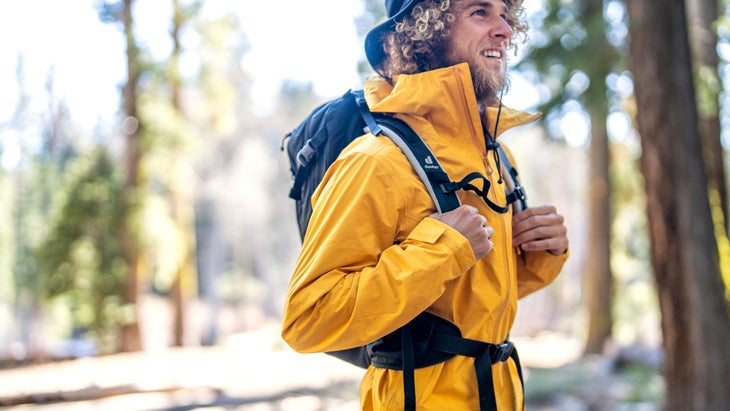
Best Quiver-Killer Shell
Helly Hansen Verglas Infinity Shell Jacket 2.0
$350 at REI $350 at Backcountry
Weight: 15.7 oz (L)
Sizes: S-XXL
Pros and Cons
⊕ Versatile
⊕ Durable
⊕ Waterproof
⊕ Ski-friendly features
⊗ Warm above 50 degrees
⊗ Middling breathability
What the multitool is to a toolbox, Helly Hansen’s Verglas Infinity 2.0 is to your adventure wardrobe: If you don’t want several specialized shells hanging in your closet, this rain jacket is a solid one-shell-fits-all solution. Thanks to a tester-approved, midweight, impressively waterproof three-layer fabric and pit zips, the shell handles most activities and conditions, from ski-touring in a snowstorm to cooler summer backpacking trips.
The three-layer shell uses the brand’s proprietary Lifa Infinity waterproof-breathable membrane, which gives hikers and mountaineers “bombproof protection,” according to Jason Boyle, a New Mexico-based backpacker, gear tester, and retired member of the U.S. Coast Guard. Boyle got caught in an intense thunderstorm while descending Black Mountain in the Sangre de Cristos, and after 20 minutes of heavy rain and a 15-degree temperature drop, he was still completely dry and comfortable.
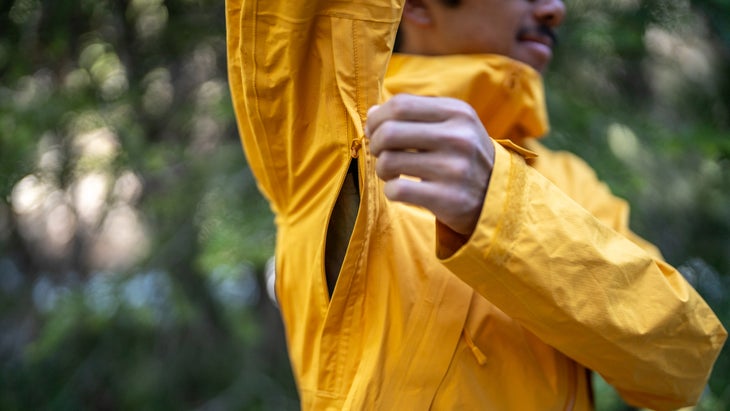
A self-proclaimed “hot hiker,” Boyle appreciated the airflow provided by the Verglas 2.0’s pit zips, but deemed the breathability middle-of-the-pack after overheating while hiking in 50-degree weather. This concession was well worth it, he felt, given the impressive weatherproofing and overall ruggedness of the jacket. “The durability seems stellar,” he reported after a six-day backpacking trip with a 40-pound starting pack weight in the Sangre De Cristos. “No issues with rubbing from shoulder straps, all the seams are taped with no peeling, and the zippers and pulls continue to operate smoothly.”
The jacket underwent a redesign in the fall of 2024 with lighter, protective pocket flaps instead of beefy, waterproof zippers, upgraded 100-percent recycled polyester face fabric, a 2.7-ounce weight drop, and a significant $100 price drop.
Helly Hansen may have slashed weight, but it didn’t skimp on features. Boyle loved the high collar, velcro cuff closures, and easily adjustable elastic hem, noting “I could cinch everything down tight to keep out precip.” The only concession? The brimmed hood was a bit tight with a ski helmet but more than generous for a climbing lid.
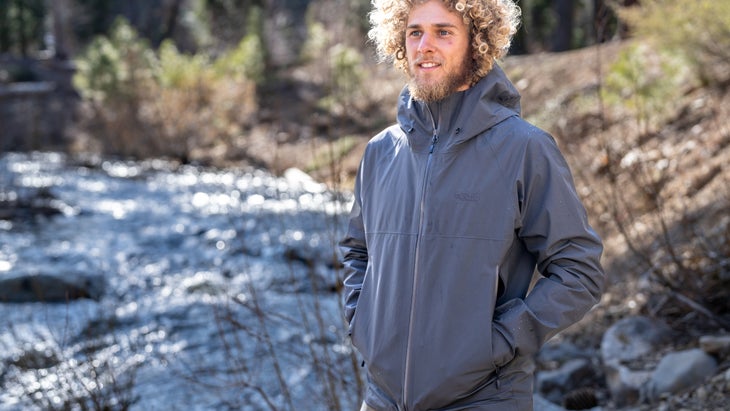
Best All-Arounder
Rab Namche Paclite
$265 at Backcountry $265 at Amazon
Weight: 12.8oz (M)
Sizes: S-XXL
Pros and Cons
⊕ Affordable
⊕ Excellent wind and weather protection
⊗ No pit zips
⊗ 2.5-layer construction can get sticky
A fairly priced inclement weather insurance policy that packs down to the size of a grapefruit, Rab’s Namche Paclite speaks to hikers who want a balance between weight savings and maximum waterproofing. “There are no bells and whistles,” says Alaskan gear tester Dorn Van Dommelen. “I’ve always been happiest with simple-but-functional gear. This jacket fits that bill.”
The rain jacket’s Gore-Tex Paclite material, a 2.5-layer construction that pairs a 75-denier face fabric with a PFC-free Gore-Tex membrane, saves weight without sacrificing weatherproofing. “I’ve had lighter shells, but this one struck the perfect balance between lightness and sturdiness,” reported Van Dommelen. Another tester was impressed with the Namche’s wind protection during a 30-mile-per-hour day on Lake Tahoe. The only downside? A slightly stickier interior when working up a sweat compared to three-layer options.
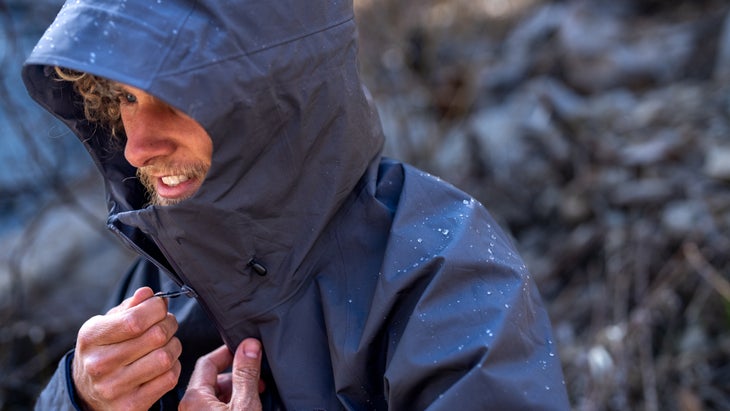
While hiking in the precipitation-prone temperate rain forests of Chugach State Park, the Paclite shell proved impressively breathable. “It was comfortable to wear and never led me to overheat,” said Van Dommelen. He was equally impressed with the Namche’s durability after bushwacking through outerwear-obliterating devil’s club in Anchorage’s Kincaid Park. “It still looks pretty new,” he reported.
Our testers found the Namche’s feature set on the modest side. It includes snag-free zippers, an easily adjustable hood (“a helmet fits, but it’s not ideal,” according to Van Dommelen), and a cinchable hem when it’s time to batten down the hatches. There are no pit zips—no big deal in the cooler climes of Alaska, but an annoyance for our California-based testers who made good use of the two spacious, venting mesh-lined hand pockets instead.
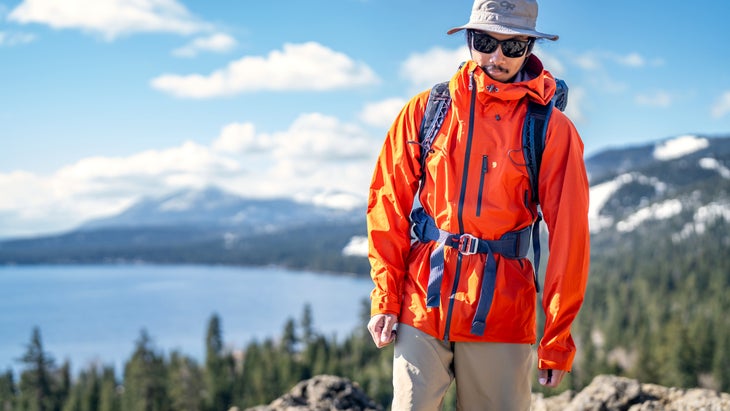
Best Stretch
Fjällräven Bergtagen Lite Eco-Shell
Weight: 13.2 oz (M)
Sizes: XS-XXL
Pros and Cons
⊕ Recycled materials
⊕ Soft, stretchy, comfortable, quiet fabric
⊕ Solid weatherproofing
⊗ Sticky zippers
⊗ Controversial vent placement
⊗ Expensive
The Bergtagen Lite, Fjällräven’s take on a packable, stretchy, multi-sport rain shell, is a far cry from the brand’s usual thick, waxed canvas and heavy wool. It uses a standard three-layer recipe with a super-stretchy, soft-to-the-touch, 100-percent recycled DWR-treated polyester outer shell.
While hunting in blowing wind and rain, the shell kept Lang Van Dommelen, a longtime gear tester from Alaska, “mostly dry—even with copious bushwhacking through chest-high grass.” The pliable fabric provided generous range of motion and on-trail movement, even with its svelte profile. “The shell breathes well, and it’s stretchy compared to other hardshells, so it’s quiet and doesn’t feel constricting,” he reported.
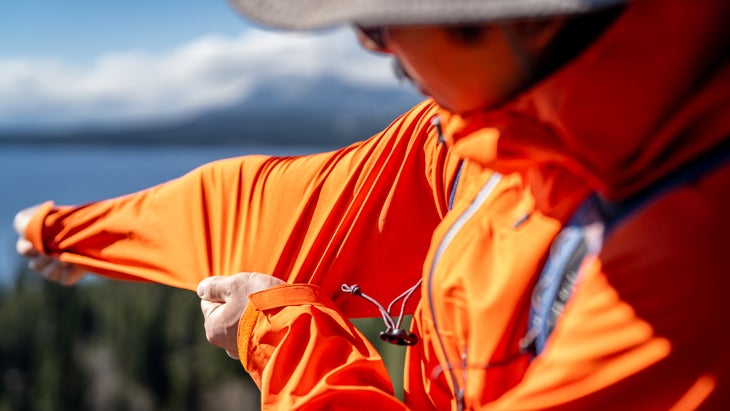
Despite his high praise, Van Dommelen had a few bones to pick. He continuously found the center zipper “sticky” and disliked the placement of the jacket’s twin vents, which run along the ribs as opposed to underneath the armpits. Other testers preferred the vent positioning, finding the zips easy to operate one-handed and less awkward and time-consuming than standard pit vents.

Most Stylish
Salewa Puez Powertex Hybrid Jacket
Weight: 14 oz (L)
Sizes: XS-XL
Pros and Cons
⊕ Attractive design
⊕ Nifty pocket construction
⊕ Great fit
⊗ Small pit zips
⊗ Not helmet compatible
Salewa has reached peak fashion with its Puez Powertex Hybrid Jacket, a debonair-yet-technical shell with creative pockets, earthy colorways, and a modern silhouette that impressed our testers both in the mountains and in the mirror.
“It doesn’t have you looking like a skittle,” reported Ryan Irvin, a climber, splitboarder, and snowmachiner based in Alaska. In addition to appreciating the under-the-radar colorways, he dug the profile, calling it “one of the best fits I’ve ever had in a shell—the perfect balance of slim and non-cumbersome with room for extra layering underneath.”
The most fashion-forward part of this jacket is the pocket layout—Salewa stacked a pair of horizontal pockets with snap button closures over standard, side-accessed, zippered hand pockets. “I loved the double-pocket design,” says Irvin, who used the top-down pockets for valuables like his phone and keys and the side pockets for warming his hands on chilly hikes.

When precipitation accompanied chillier temperatures, Irvin found the shell fabric “very protective—even on the wettest days of mushroom foraging and bushwhacking through thick Alaskan brush.” Salewa deployed a 100-percent recycled three-layered polyester ripstop along the upper arms, shoulders, and torso, with a lighter 2.5-layer design around the waist and hood to save weight.
The Puez is breathable to a point: Irvin found moisture management adequate while hiking steep slopes in the Yukon, but he overheated when trail running in moderate temperatures. Other testers made use of the two snapping buttons alongside the central zipper, which allow you to vent the jacket unzipped without it flapping willy-nilly in the wind.
Testers had a love-hate relationship with the hood. They judged it too small for most helmets but adored the stretchy band Salewa integrated beneath the semi-rigid brim. “It secured the hood perfectly in gale force winds without feeling like I had Saran Wrap on my forehead,” reported Irvin. “Classy, functional, comfortable, and protective, this is going to be a daily driver for me in southeast Alaska,” he concluded.
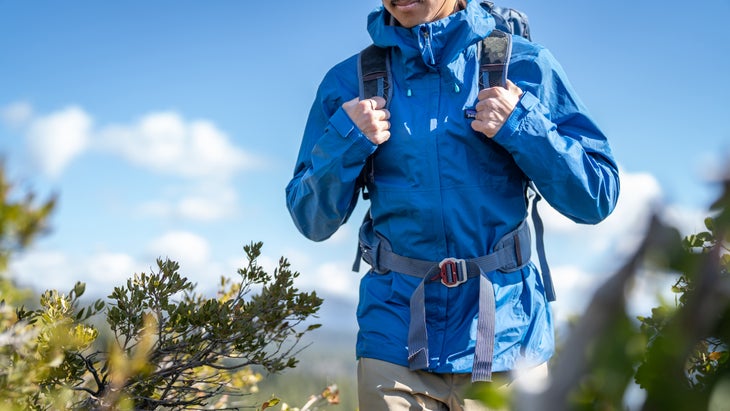
Most Value
Patagonia Torrentshell
$179 at REI $179 at Backcountry
Weight: 14.1 oz (M)
Sizes: XS-XXXL
Pros and Cons
⊕ Affordable
⊕ Durable
⊕ Excellent weatherproofing
⊗ Middling breathability
⊗ Bulky fit
⊗ Hood is tight for a helmet
Patagonia’s tried-and-true Torrentshell continues to be a top pick for value-driven outdoor enthusiasts, thanks to reliable weatherproofing at an affordable price.
This rain jacket is a true three-layer shell—impressive at a sub-$200 price point— with a 50-denier, 100-percent recycled nylon ripstop face fabric and Patagonia’s proprietary PFC-free PU membrane. Tester Cody Memmel, a tough-to-please Colorado-based fly fisherman, climber, and hiker, was particularly impressed with its hydrophobic chops: “This shell was one of the more storm-worthy jackets I have ever worn,” he said, appreciative of the ability to cinch down the hood, hem, and wrists, as well as the double-guttered front zipper. He gave Patagonia props on the fabric after a sunny day of fishing the Gunnison River turned into a torrential downpour: “The H2No membrane was stellar and it had no issues shedding water or pea-sized hail.” He gave the shell similar accolades for durability, calling it “a tank.”

Gerben Scherpier, a sea kayak guide in Maine, former Yellowstone backcountry ranger, and longtime gear tester, co-signed these findings, giving the Torrentshell a rare 10 out of 10 in the durability department. “It’s one of the more hardy jackets I have tested,” he said—high praise after 13 years of shell testing. “I sat on rough rocks, wore it through dense brush during an orienteering race, and the shoulders endured miles of abrasive rubbing from my pack straps—and you can’t tell at all.” He did acknowledge that the fabric is stiff right out of the gate, but softens with time and wear.
Memmel appreciated the dual hand pockets, which he judged “standard but functional.” He was also grateful for the pit zips when hightailing it in the high country, as the weatherproofing and durability do come at the cost of breathability. “The shell never felt clammy, but it definitely let you know when you needed to dump a layer or open the pit zips,” he said. Scherpier concurred, claiming the long zippered vents “saved me from overheating” during a blustery, drizzly hike up Yellowstone’s Bunsen Peak.
The only point of contention for our test team was fit. More athletically-built testers like Scherpier happily judged the fit “unremarkable,” and he was able to toss a puffy under the shell while waiting for friends to catch up on the summit of New Hampshire’s Mt. Lafayette. Memmel, a more slender tester, found the fit “bulky” and “baggy” and the hood a bit too tight over his climbing helmet while leading the last pitch of a climb in Unaweep Canyon.
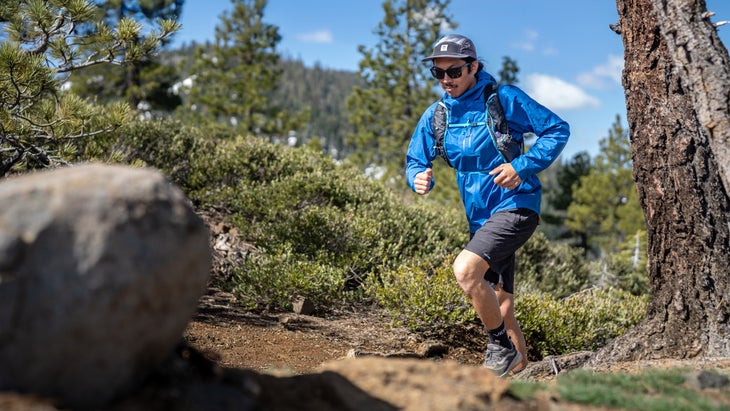
Best for Trail Running
Patagonia Storm Racer
$299 at REI $299 at Backcountry
Weight: 7.2 oz (M)
Sizes: XS-XL
Pros and Cons
⊕ Versatile
⊕ Lightweight for three-layer hardshell
⊗ No pit zips
The most substantial layer in Patagonia’s trail-running line, the recently redesigned Storm Racer is a fully waterproof, three-layer shell that weighs under a half-pound in a size medium. In 2024, Patagonia reverted from a unique, vest-accommodating, dual-zippered design to a more standard front chest zip—a change that makes the shell more versatile and better-suited for additional pursuits, from backpacking and fly fishing to gravel biking and strolling around town. Another noteworthy update: The addition of a chest zip pocket, which fits a phone and pair of light gloves.
All testers appreciated the Storm Racer’s weatherproofing-to-weight ratio, especially compared with other running shells. One tester gushed that the 7.2-ounce men’s medium felt “almost weightless” whether it was stuffed in his pack or draped over his shoulders, and reported that the jacket packs down to the size of a hockey puck.

The current regular-zip version is slimmed down and intended to fit under a running vest, although one of our svelter testers did manage to pull it over his vest for drizzly trail runs in Tahoe.
Unlike skimpier trail running shells, the H2No membrane and 20-denier nylon ripstop face fabric can actually handle extended soggy sojourns. The hood sports a pull-tab in the back, which I found easy to adjust while jogging on off-camber trails. Thanks to that adjustability and the structure of the fabric, the stiff hood provides reliable coverage during downpours. Breathability isn’t as compromised as you might expect, either. “It kept the rain out without locking the heat in, capturing the balance that every high-altitude runner seeks,” opined Horn. Still, we wouldn’t mind the addition of pit zips, especially in a trail-running focused shell.

Best Backpacking Shell
Mountain Hardwear Premonition UL Jacket
$430 at REI $430 at Backcountry
Weight: 11.2 oz (M)
Sizes: S-XXL
Pros and Cons
⊕ Solid waterproofing
⊕ Packable
⊕ Minimalist design
⊗ Lingering chemical smell
⊗ Not super breathable
Alaska-based tester Dorn Van Dommelen tested Mountain Hardwear’s Premonition UL during a record-breaking stretch of rain in Anchorage, making his stamp of approval especially meaningful. Van Dommelen judged the jacket’s 20-denier, 3-layer Pertex Shield fabric thin and lightweight, but he found it still kept him “remarkably dry in complete hypothermia weather” after bushwacking through wet willow and dwarf birch on the Upper Teklanika River in Denali National Park.
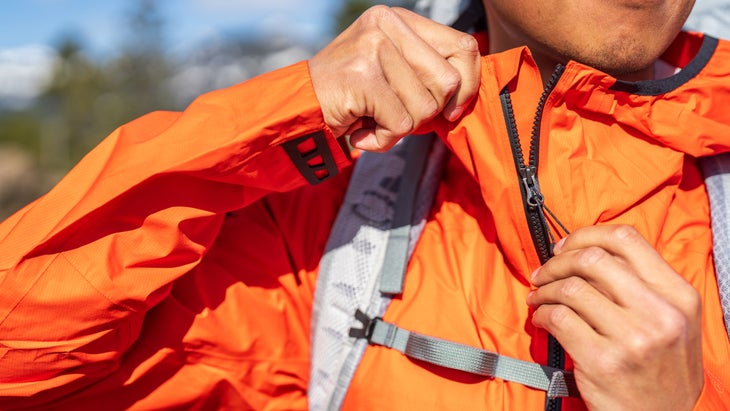
Moments like those showcased the shell’s durability, too—despite countless encounters with bark and brush, “the jacket still looks as good as new,” he reported. Other testers in the relatively balmy Sierra noted that the fabric offered adequate breathability, but sacrificed some moisture-wicking for pure precip protection.
In terms of features, the Premonition UL comes with snap-closure pit vents. Van Dommelen deemed them “a bit odd, but they seem to work just fine,” though he otherwise appreciated Mountain Hardwear’s aversion to superfluous bells and whistles. The shell sports two zippered hand pockets, a zippered internal pocket, and an adjustable, helmet-compatible hood—practical necessities, keeping the packed volume minimal and gram counters happy. Testers’ main complaint? A strong, residual chemical odor that remained long after unboxing.
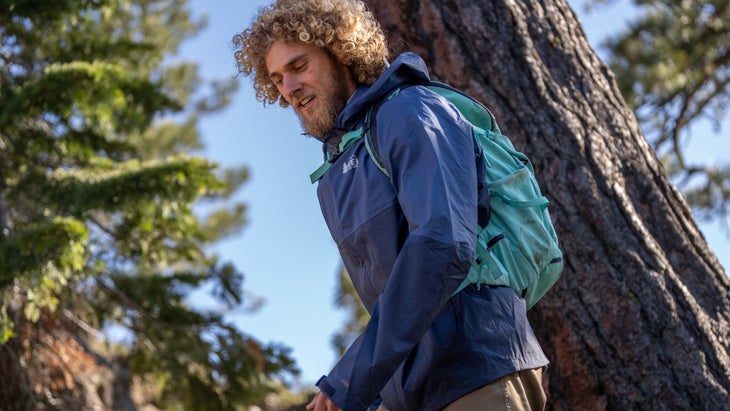
Best Budget
REI Co-op Rainier
Weight: 11.3 oz (M)
Sizes: S-XXXL
Pros and Cons
⊕ Cheap
⊕ Solid waterproofing
⊕ Above-average durability
⊕ Fully-featured
⊗ Average breathability
⊗ Not super packable
The Rainier, a 2.5-layer, 100-percent recycled nylon ripstop rain shell from REI Co-op’s in-house label, outperformed every shell we tested in one category: price. And according to Wyoming-based tester Chris Odom, the shell punches above its price tier with regard to waterproofing and durability. After taking the Rainier for daily morning walks during a chilly, stormy stretch in the Tetons, Odom reported that the looser fit (but slightly less boxy than last year’s version) accommodated insulating layers, the fabric had enough elasticity for natural range of motion, and, above all else, the shell “stepped up and did what it was supposed to do: keep me warm and dry.” Odom’s ultimate durability test? Stacking a half-cord of wood during a downpour. “I was impressed—I didn’t get wet, there were no rips caused by wood scratching the face fabric, and most surprisingly, I didn’t overheat,” he said.
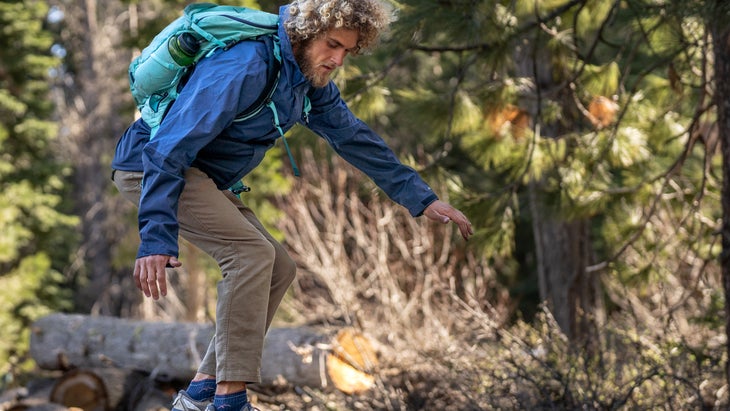
Given the price, we were happily surprised with the Rainier’s feature set. REI Co-op outfitted the jacket with pit zips, cinching cuffs, internal dump pockets, and a Velcro storm flap over the main zipper (some Outside testers like this belt-and-suspenders approach, others judge it overkill). During a Teton rainstorm, zippered hand pockets kept Odom’s paws dry. REI Co-op also revamped the hood, switching from an internal collar to a slimmer, more standard hanging hood. Odom reported that between a semi-rigid visor, elastic pull cord, and the chin coverage of the front zip, he was able to adjust the angles of the hood to block rain and wind while retaining visibility during heavy downpours. For a C-note, the Rainier is an indisputable steal.
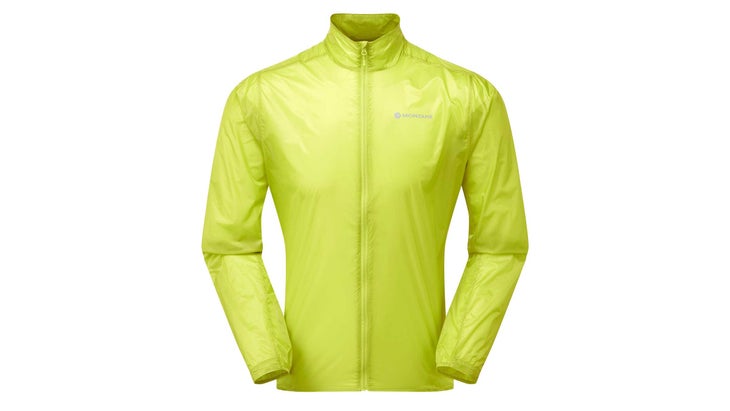
Best Emergency Layer
Montane Featherlite Nano
Weight: 1.8 oz (M)
Sizes: XS-XXL
Pros and Cons
⊕ Ultralight
⊕ Surprisingly durable
⊕ Surprisingly weatherproof
⊗ No hood or chest pocket
⊗ Tight fit
Montane’s Featherlite Nano is just a few grams heavier than the Crazy Jacket Fly, the lightest shell we’ve ever test. While the bare-bones Nano doesn’t sport a hood like the Fly, the fabric is more durable and weatherproof, making it an attractive emergency layer. Smitten tester Jeff Schwartz, a Grand Canyon National Park backcountry ranger, called it “virtually weightless.” On a seemingly temperate day hike up Wyoming’s Medicine Bow Peak, Schwartz ditched a heavier shell and packed the baseball-sized Nano just in case. The Pertex Quantum 10-denier recycled nylon kept him dry when a 10 percent chance of rain turned into 100 percent during an intense downpour.
Breathability is exceptional, which Schwartz confirmed biking along the Grand Canyon’s South Rim—an adventure that resulted in him dubbing the Nano his “new favorite jacket for road biking.” More shockingly, he reported that the gossamer fabric emerged from three days of bushwacking and backpacking in Idaho’s Sawtooths completely unscathed. For the most part, Schwartz was content to jettison features for minimal weight and packability, but he did miss a chest pocket to house his tunes on trail runs. Lastly, he judged fit on the tight side—consider sizing up if you’re between sizes.
Rain Jacket Comparison
| Jacket | Price | Pros | Cons |
| Helly Hansen Verglas Infinity Shell Jacket 2.0 | $350 | Versatile; ski-friendly features | Warm above 50 degrees |
| Rab Namche Paclite | $265 | Excellent wind and weather protection | No pit zips; gets sticky |
| Fjällräven Bergtagen Lite Eco-Shell | $425 | Recycled materials; solid weatherproofing | Sticky zippers; expensive |
| Salewa Puez Powertex Hybrid Jacket | $300 | Attractive design; great fit | Small pit zips; not helmet compatible |
| Patagonia Torrentshell 3L | $179 | Affordable; durable | Middling breathability; bulky fit |
| Patagonia Storm Racer | $299 | Versatile; lightweight | No pit zips |
| Mountain Hardwear Premonition UL | $430 | Solid waterproofing; packable | Lingering chemical smell |
| REI Co-op Rainier | $100 | Affordable; fully-featured | Average breathability |
| Montane Featherlite Nano | $130 | Ultralight; surprisingly durable | No hood or chest pocket |
How to Choose a Rain Jacket
If we had to describe the perfect rain jacket, it’s one that can handle any adventure in every condition, from trail runs on breezy ridgetops to backpacking missions in snow and sleet. Unfortunately, the perfect shell doesn’t exist. Subsequently, if there’s one word to keep in mind when shopping for a shell jacket, it’s “compromise.” Here are the most important factors to keep in mind when deciding which features to prioritize.
Specialized Shells vs. All-Around Shells
Specialized shells that crush a particular type of condition or activity are woefully under-gunned—or over-gunned—for other types. For instance, a high-denier three-layer shell is overkill and too heavy for most hikes and backpacking trips. Vice versa, all-around shells that can handle multiple activity types are often not the best at those activities. The Helly Hansen Verglas 2.0, our favorite “quiver killer” shell, can handle ski tours and moderate hikes, but it’s not our favorite in either category.
Weight vs. Durability
Weight is another aspect that requires compromise. The lightest shells, like the Montane Featherlite Nano, sacrifice elements like durability (and/or waterproofing). Heavier shells like the Patagonia Torrentshell can scrape against rocks without worry, but it’s not breaking any records for weight.
Budget vs. Quality
Of course, compromise is also at play when it comes to budget. While we’ve included our top budget pick—the REI Rainier, which provides excellent protection at a $100 price point—you generally get what you pay for. If you’re buying a cheap shell, you may be making a compromise on performance, or at the very least, technical ability.
As you step into the realm of more technical, higher-quality three-layer fabrics (a sandwich of a bonded inner liner, waterproof and breathable membrane, and protective face fabric that’s widely accepted as the best armor in extreme conditions), expect to pay more. Case in point? Our favorite trail shell, the Mountain Hardwear Premonition UL Jacket, which is four times the price of the REI budget pick.
Waterproofing vs. Breathability
Waterproofing and breathability are discussed ad nauseam in shell jacket product descriptions and gear reviews because they’re some of the most critical elements. The best shell jackets will keep you dry from both precipitation and perspiration, and manufacturers use different semi-permeable membranes, most famously Gore-Tex, to defend against precip while allowing sweat to escape. Again, this comes down to compromise: more waterproofing comes at the cost of breathability, and vice versa.
Softshell vs. Hardshell Jackets
No discussion of waterproofing versus breathability is complete without touching on the designation between hardshell and softshell jackets. Hardshells are typically stiffer in hand, more waterproof, and less breathable. Softshells are, as the name suggests, softer to the touch, and they usually provide better active wicking, but are less trustworthy in serious precipitation. Oftentimes, hardshells are only deployed when weather rolls in, while softshells can be worn all day long because they’re more breathable. There are Pros and Cons to each, so we like to have both in our closet. That said, if you’re only going to get one shell, our recommendation is that it should be a hardshell, which is more adaptable year-round.
Compromising and the Art of the Quiver
If you’re a skier or snowboarder, mountain biker or surfer, fly fisherman or kayaker, you’re likely familiar with the art of the quiver. The average skier, for instance, may be content having one pair of all-mountain skis, but advanced skiers will often build a quiver of multiple pairs to better react to changing conditions and objectives. In addition to their all-mountain skis, they may have a pair for powder, a pair for the terrain park, and a pair for backcountry—you get the picture. The same concept can be applied to shell jackets.
If you’re a dedicated specialist, like a trail runner or a mountaineer, it makes sense to start with a specialized shell. But if you’re an indiscriminate outdoor enthusiast who bikes one weekend and hikes the next, it makes sense to start with an all-arounder, like the Helly Hansen Verglas 2.0. Then you can add specialists: an ultralight emergency layer like the Montane Featherlite Nano, or our top pick for trail runners, the Patagonia Storm Racer.
Final Tips for Shell Shopping
- When shopping for a shell, it’s important to keep fit and layering in mind. If you’re supporting your local gear shop and you plan to wear a puffy underneath your shell, bring your puffy with you when you shop.
- If you’re planning to use the shell while climbing or biking, make sure you try it on with a helmet.
- If you’re shopping online, shop from a place like REI or Backcountry that has a customer-friendly return policy.
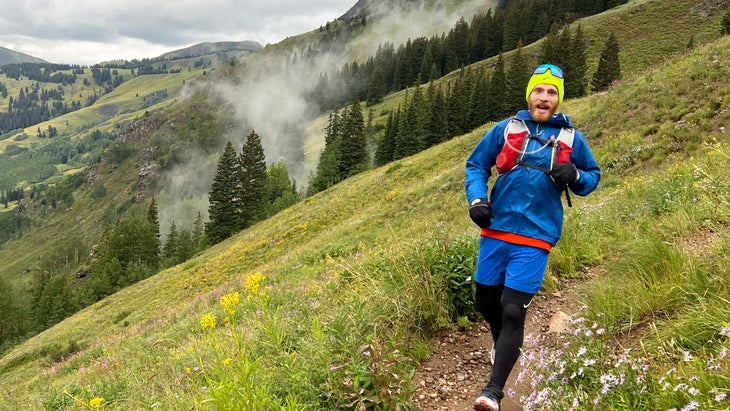
How We Test Rain Jackets
- Number of Testers: 37
- Number of Jackets: 52
- Highest Elevation Climbed: 14,344 feet on Colorado’s La Plata Peak
- Most Consecutive Days of Precipitation: A tie between 7 days in Crested Butte, CO, and 7 days in Scotland
- Fastest Wind Weathered: 60 mph
- Most Mushrooms Harvested: 2.5 pounds of chanterelles
- Most Wild Hogs Encountered: 8
Last summer, we put the call out to brands big and small, asking them to submit their best rain jackets to our annual test. They ranged from ultralight trail running shells and emergency layers to heavy-duty softshells and three-layer armor better suited to alpine pursuits. We sent those rain shells out to a network of testers across the country. Testers ranged in age and location, from young whippersnappers in Tahoe to gray-bearded mountain men in Alaska. The most heavily represented hubs were Anchorage, Alaska, Salt Lake City, Utah, and Truckee, California.
Our testers used the shells during work trips, from a hut-keeper doing his morning chores in the Sierra to a kayak guide paddling along the coast of misty Maine. They also tested shells on regular adventures and daily outings, like a wet, foggy surf trip on the Northern California coast, muddy bike park laps at their local ski resorts, and a rainy trail run on Aspen’s famed Four Pass Loop.
After putting shells through the wringer, we asked testers to fill out detailed review forms. They scored shells quantitatively on aspects like durability, waterproofing, and breathability. Then, they answered in-depth, qualitative questions. Afterwards, I sifted through the review forms and tested top contenders myself. Finally, we compared the newest batch of jackets to our tried-and-tested favorites.
Meet Our Testers
Drew Zieff
Drew Zieff is a Tahoe-based freelance writer and Backcountry Magazine’s Rider In Chief. He also writes for REI, Gear Junkie, and Forbes, among others. A regular Outside contributor, he heads up our snowboard gear coverage in the winter. In the summers, he covers men’s shells, car camping accessories, and car camping kitchen gear. To test, he explores his backyard, takes road trips in his custom-built Chevy Express, or ventures further afield. This past summer and fall, he tested shells on surf trips to the California coast, fly fishing trips to Oregon and Colorado, a rain-soaked wedding in Vermont, and hikes and trail runs in his local Sierra.
Scott Simper
Scott Simper is a Utah-based, world-traveling director of photography. His resume is as impressive as it is broad: he’s climbed Everest twice, won the Banff Film Fest audience award a whopping three times, worked on Deadliest Catch, and added an Emmy to his shelf thanks to his work on NBC’s coverage of the 2011 Ironman World Championship. Simper put shells to the test in his backyard in Utah’s Wasatch, on both coasts during film projects in the Pacific Northwest’s Cascades and Maine’s North Woods, and abroad in Africa and New Zealand.
Chris Cloyd
Chris Cloyd is a June Lake, CA, based devotee of the Eastern Sierra and a longtime Outside snowboard tester. A former touring musician, professional ultra-runner, and physical trainer, Cloyd now spends his summers hut-keeping for the Truckee Donner Land Trust’s immaculate Frog Lake Backcountry Huts, and his winters as a snowboard guide leading powderhounds to lines of a lifetime at High Sierra Snowcat. In between, he directs the occasional trail race for the Donner Party Mountain Runners, because why not? This year, he tested shells while hut-keeping at Frog Lake and scrambling ridges and rock high in the Sierra.
Related
The Ultimate Backpacking Checklist
